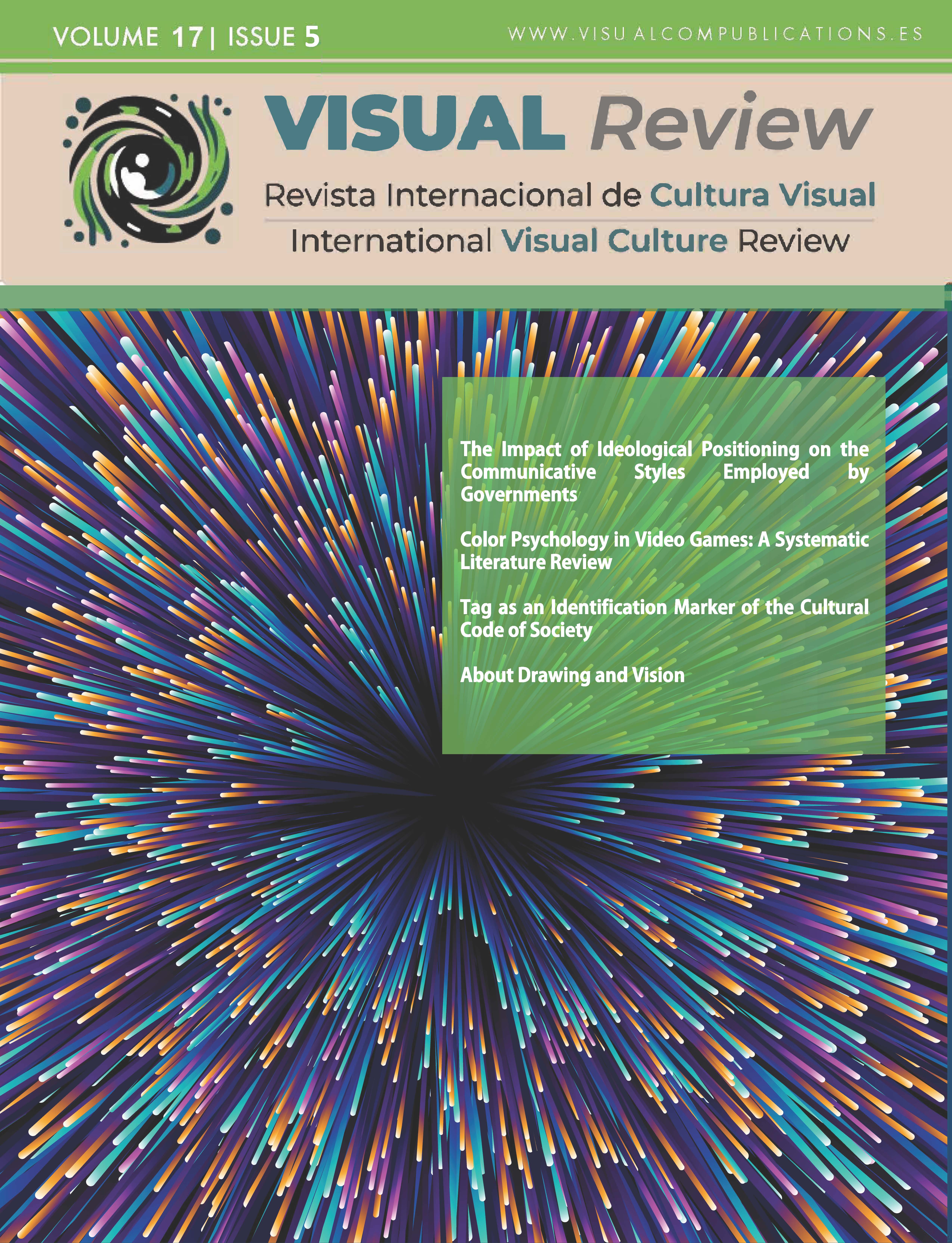Color Psychology in Video Games
A Systematic Literature Review
DOI:
https://doi.org/10.62161/revvisual.v17.5727Keywords:
Color psychology, Videogame, Emotions, Color, Graphic Interface, Digital InteractivityAbstract
The video game industry is expanding, and it is necessary to determine if color psychology applies to its graphical interface. The main objective is to understand how the use of color psychology in video games has been studied. This study conducts a systematic review of color theory and its impact on the graphical interface. Existing studies highlight the role of color in communicating with users and enhancing game mechanics and narratives. This proposal recommends standardized criteria for evaluating color psychology in video games.
Downloads
Global Statistics ℹ️
|
556
Views
|
273
Downloads
|
|
829
Total
|
|
References
Amini Vishteh, R., Mirzajani, A., Jafarzadehpour, E., & Darvishpour, S. (2019). Evaluation of Simple Visual Reaction Time of Different Colored Light Stimuli in Visually Students. Clinical Optometry, 11, 167–171. https://doi.org/10.2147/OPTO.S236328 DOI: https://doi.org/10.2147/OPTO.S236328
Balakrishnan, G., Uppinakudru, G., Girwar Singh, G., Bangera, S., Dutt Raghavendra, A., & Thangavel, D. (2014). A Comparative Study on Visual Choice Reaction Time for Different Colors in Females. Neurology Research International, 2014. https://doi.org/10.1155/2014/301473 DOI: https://doi.org/10.1155/2014/301473
Bird, C. M., Berens, S. C., Horner, A. J., & Franklin, A. (2014). Categorical encoding of color in the brain. Proceedings of the National Academy of Sciences of the United States of America, 111(12), 4590–4595. https://doi.org/10.1073/PNAS.1315275111 DOI: https://doi.org/10.1073/pnas.1315275111
Cai, D., Goto, S., Shinohara, T., Nagata, N., Kurumisawa, J., & Fukumoto, A. (2010). Synesthetic color scheme in Fantasia. ACM SIGGRAPH 2010 Talks, SIGGRAPH ’10. https://doi.org/10.1145/1837026.1837063 DOI: https://doi.org/10.1145/1837026.1837063
Cook R., Kay P., & Regier T. (2009, July). The World Color Survey. https://www1.icsi.berkeley.edu/wcs/
De Melo, C. M., & Gratch, J. (2009). The effect of color on expression of joy and sadness in virtual humans. Proceedings - 2009 3rd International Conference on Affective Computing and Intelligent Interaction and Workshops, ACII 2009. https://doi.org/10.1109/ACII.2009.5349585 DOI: https://doi.org/10.1109/ACII.2009.5349585
DEV. (2023). Libro Blanco del Desarrollo español de los videojuegos. https://dev.org.es/images/stories/docs/libro%20blanco%20del%20desarrollo%20espanol%20de%20videojuegos%202022.pdf
Dresp-Langley, B., & Wandeto, J. M. (2021). Human Symmetry Uncertainty Detected by a Self-Organizing Neural Network Map. https://doi.org/10.3390/sym13020299 DOI: https://doi.org/10.20944/preprints202101.0313.v1
Ekman, P., & Friesen, W. V. (1971). Constants across cultures in the face and emotion. Journal of Personality and Social Psychology, 17, 124–129. https://doi.org/https://doi.org/10.1037/h0030377 DOI: https://doi.org/10.1037/h0030377
Elliot, A. J. (2015). Color and psychological functioning: A review of theoretical and empirical work. Frontiers in Psychology, 6(APR). https://doi.org/10.3389/fpsyg.2015.00368 DOI: https://doi.org/10.3389/fpsyg.2015.00368
Elliot, A. J., & Maier, M. A. (2012). Color-in-Context Theory. Advances in Experimental Social Psychology, 45, 61–125. https://doi.org/10.1016/B978-0-12-394286-9.00002-0 DOI: https://doi.org/10.1016/B978-0-12-394286-9.00002-0
Elliot, A. J., & Maier, M. A. (2014). Color psychology: effects of perceiving color on psychological functioning in humans. Annual Review of Psychology, 65, 95–120. https://doi.org/10.1146/ANNUREV-PSYCH-010213-115035 DOI: https://doi.org/10.1146/annurev-psych-010213-115035
Elliot, A. J., & Maier, M. A. (2016). Color and Psychological Functioning. Https://Doi.Org/10.1111/j.1467-8721.2007.00514.x, 16(5), 250–254. https://doi.org/10.1111/J.1467-8721.2007.00514.X DOI: https://doi.org/10.1111/j.1467-8721.2007.00514.x
Geslin, E., Jégou, L., Beaudoin, D., & Oliveira, M. M. (2016). How color properties can be used to elicit emotions in video games. International Journal of Computer Games Technology, 2016, 1–9. https://doi.org/10.1155/2016/5182768 DOI: https://doi.org/10.1155/2016/5182768
Goethe J. W. (1810). Goethe’s Theory of Colours. https://books.google.es/books?hl=es&lr=&id=OIoIAAAAMAAJ&oi=fnd&pg=PR35&dq=goethe+w.+(1810).+theory+of+colors&ots=xZyHAYFg6d&sig=2yRdH9JASTnlkhi4Lp3aAoa4aFA#v=onepage&q&f=false
Gómez-Luna, E., Fernando-Navas, D., Aponte-Mayor, G., Luis, &, & Betancourt-Buitrago, A. (2014). Metodología para la revisión bibliográfica y la gestión de información de temas científicos, a través de su estructuración y sistematización. Dyna, 81(184), 158–163. https://www.redalyc.org/articulo.oa?id=49630405022 DOI: https://doi.org/10.15446/dyna.v81n184.37066
Grijalva, P. K., Cornejo, G. E., Gómez, R. R., Real, K. P., & Fernández, A. (2019). Herramientas colaborativas para revisiones sistemáticas. Revista ESPACIOS, 40, https://www.revistaespacios.com/a19v40n25/19402509.html
Haghi, M., Alizadehashrafi, B., & Nasr-Esfahani, S. (2019). The Effect of the Colours on the Perception of Time among Players of Computer Games: A Narrative Review. Journal of Research in Rehabilitation Sciences, 15(4), 235–242. https://doi.org/10.22122/JRRS.V15I4.3469
Heidari-Gorji, H., Zabbah, S., & Ebrahimpour, R. (2018). A temporal neural network model for object recognition using a biologically plausible decision making layer.
Heller, E. (2004). Psicología del color: cómo actúan los colores sobre los sentimientos y la razón.
Hussain, Z., Astle, A. T., Webb, B. S., & McGraw, P. V. (2014). The challenges of developing a contrast-based video game for treatment of amblyopia. Frontiers in Psychology, 5(OCT), 112903. https://doi.org/10.3389/FPSYG.2014.01210/BIBTEX DOI: https://doi.org/10.3389/fpsyg.2014.01210
Iglesias-Martínez, M. E., Hernaiz-Guijarro, M., Castro-Palacio, J. C., Fernández-De-córdoba, P., Isidro, J. M., & Navarro-Pardo, E. (2020). Machinery Failure Approach and Spectral Analysis to Study the Reaction Time Dynamics over Consecutive Visual Stimuli: An Entropy-Based Model. Mathematics 2020, Vol. 8, Page 1979, 8(11), 1979. https://doi.org/10.3390/MATH8111979 DOI: https://doi.org/10.3390/math8111979
Itten. (1961). The Art of Color the Subjective Experience and Objective Rationale of Color. https://philpapers.org/rec/ITTTAO-2
Jin, Y., Kim, J., & Yoo, J. J. (2023). Study on reaction time depending on display parameters of gaming displays. Journal of the Society for Information Display, 31(8), 511–521. https://doi.org/10.1002/JSID.1198 DOI: https://doi.org/10.1002/jsid.1198
Joosten, E., Lankveld, G., & Spronck P. (2010). Colors and Emotions in Video Games. https://www.researchgate.net/publication/239842533_Colors_and_Emotions_in_Video_Games
Joosten E., Lankveld G., & Spronck P. (2012). Influencing Player Emotions Using Colors. https://www.researchgate.net/publication/357992041_Influencing_Player_Emotions_Using_Colors
Labrador E. (2020, March 18). El uso del color en los videojuegos. https://books.google.es/books/about/El_uso_del_color_en_los_videojuegos.html?id=ADP8DwAAQBAJ&redir_esc=y
Levitan, C. A., Ren, J., Woods, A. T., Boesveldt, S., Chan, J. S., McKenzie, K. J., Dodson, M., Levin, J. A., Leong,
Kandinsky W. (1911). De lo espiritual en el arte. https://1library.co/document/yr67mvpy-wassily-kandinsky-lo-espiritual-arte-nave-los-locos.html
C. X. R., & Van Den Bosch, J. J. F. (2014). Cross-cultural color-odor associations. PloS One, 9(7). https://doi.org/10.1371/JOURNAL.PONE.0101651 DOI: https://doi.org/10.1371/journal.pone.0101651
Maroto, R., Alegría, P., & González Lorca Presidente de AEVI José María Moreno, A. (2022). La industria del videojuego en España en 2021.
Mehrabian, A., & Valdez, P. (1994). Effects of Color on Emotions. Journal of Experimental Psychology: General, 123(4), 394–409. https://doi.org/10.1037/0096-3445.123.4.394 DOI: https://doi.org/10.1037//0096-3445.123.4.394
Morita, A., & Kambara, T. (2021). Bizarreness and Typicality Effects of Color on Object Recognition Memory. Perceptual and Motor Skills, 128(6), 2469–2489. https://doi.org/10.1177/00315125211048391/ASSET/IMAGES/LARGE/10.1177_00315125211048391-FIG2.JPEG DOI: https://doi.org/10.1177/00315125211048391
Moscoso del Prado Martin, F. (2009). The thermodynamics of human reaction times. https://www.researchgate.net/publication/45868522_The_thermodynamics_of_human_reaction_times
Moutoussis, K. (2015). The physiology and psychophysics of the color-form relationship: A review. Frontiers in Psychology, 6(NOV), 125156. https://doi.org/10.3389/FPSYG.2015.01407/BIBTEX DOI: https://doi.org/10.3389/fpsyg.2015.01407
Newzoo Global Games Market Report 2022. (2023). https://newzoo.com/resources/trend-reports/newzoo-global-games-market-report-2022-free-version
Nicolás-Sáenz, L., Ledezma, A., Pascau, J., & Muñoz-Barrutia, A. (2023). ABANICCO: A New Color Space for Multi-Label Pixel Classification and Color Analysis. Sensors 2023, Vol. 23, Page 3338, 23(6), 3338. https://doi.org/10.3390/S23063338 DOI: https://doi.org/10.3390/s23063338
O’Connor, Z. (2011). Colour psychology and colour therapy: Caveat emptor. Color Research & Application, 36(3), 229–234. https://doi.org/10.1002/COL.20597 DOI: https://doi.org/10.1002/col.20597
Ortiz, Z. (2005). Revisiones sistemáticas. Bioquímica y Patología Clínica, 69(2), 34–36. Asociación Bioquímica Argentina. Recuperado de https://www.redalyc.org/pdf/651/65169204.pdf
Ou, L. C., Luo, M. R., Woodcock, A., & Wright, A. (2004). A study of colour emotion and colour preference. Part III: Colour preference modeling. Color Research and Application, 29(5), 381–389. https://doi.org/10.1002/COL.20047 DOI: https://doi.org/10.1002/col.20047
Page, M. J., McKenzie, J. E., Bossuyt, P. M., Boutron, I., Hoffmann, T. C., Mulrow, C. D., Shamseer, L., Tetzlaff, J. M., Akl, E. A., Brennan, S. E., Chou, R., Glanville, J., Grimshaw, J. M., Hróbjartsson, A., Lalu, M. M., Li, T., Loder, E. W., Mayo-Wilson, E., McDonald, S., … Moher, D. (2021). The PRISMA 2020 statement: An updated guideline for reporting systematic reviews. The BMJ, 372. https://doi.org/10.1136/BMJ.N71 DOI: https://doi.org/10.1136/bmj.n71
Palaus, M., Marron, E. M., Viejo-Sobera, R., & Redolar-Ripoll, D. (2017). Neural basis of video gaming: A systematic review. Frontiers in Human Neuroscience, 11, 231323. https://doi.org/10.3389/FNHUM.2017.00248/BIBTEX DOI: https://doi.org/10.3389/fnhum.2017.00248
Ravaja, N., Salminen, M., Holopainen, J., Saari, T., Laarni, J., & Järvinen, A. (2004). Emotional response patterns and sense of presence during video games: Potential criterion variables for game design. ACM International Conference Proceeding Series, 82, 339–347. https://doi.org/10.1145/1028014.1028068 DOI: https://doi.org/10.1145/1028014.1028068
Rider, R. (2009). Color Psychology and Graphic Design Applications. In Senior Honors Theses. https://digitalcommons.liberty.edu/honors/111
Rivas Yuste, M. I. (2017). Psicología del color: cómo influye el color a nuestra percepción y emociones en el audiovisual. https://idus.us.es/handle/11441/62845.
Rogers, S. (2014). Level Up! The Guide to Great Video Game Design. John Wiley & Sons. https://play.google.com/store/books/details?id=UT5jAwAAQBAJ&rdid=book-UT5jAwAAQBAJ&rdot=1&source=gbs_vpt_read&pcampaignid=books_booksearch_viewport
Salmon, J. P., Dolan, S. M., Drake, R. S., Wilson, G. C., Klein, R. M., & Eskes, G. A. (2017). A survey of video game preferences in adults: Building better games for older adults. Entertainment Computing, 21, 45–64. https://doi.org/10.1016/J.ENTCOM.2017.04.006 DOI: https://doi.org/10.1016/j.entcom.2017.04.006
Siok, W. T., Kay, P., Wang, W. S. Y., Chan, A. H. D., Chen, L., Luke, K. K., & Tan, L. H. (2009). Language regions of brain are operative in color perception. Proceedings of the National Academy of Sciences of the United States of America, 106(20), 8140–8145. https://doi.org/10.1073/PNAS.0903627106 DOI: https://doi.org/10.1073/pnas.0903627106
Song, A., Faugeras, O., & Veltz, R. (2019). A neural field model for color perception unifying assimilation and contrast. PLoS Computational Biology, 15(6). https://doi.org/10.1371/JOURNAL.PCBI.1007050 DOI: https://doi.org/10.1371/journal.pcbi.1007050
Terron-Lopez, P. (2022). El uso del color en la interfaz gráfica de los videojuegos. https://reunir.unir.net/handle/123456789/12802
Terron-Lopez, P. (2023, June 15). Node map of the reviewed papers. Color psychology in video games. A literature review. https://onodo.org/visualizations/241750
Terwogt, M. M., & Hoeksma, J. B. (1995). Colors and emotions: Preferences and combinations. Journal of General Psychology, 122(1), 5–17. https://doi.org/10.1080/00221309.1995.9921217 DOI: https://doi.org/10.1080/00221309.1995.9921217
Tham, D. S. Y., Sowden, P. T., Grandison, A., Franklin, A., Lee, A. K. W., Ng, M., Park, J., Pang, W., & Zhao, J. (2020). A systematic investigation of conceptual color associations. Journal of Experimental Psychology. General, 149(7). https://doi.org/10.1037/XGE0000703 DOI: https://doi.org/10.1037/xge0000703
Wolfson, S., & Case, G. (2000). The effects of sound and colour on responses to a computer game. Interacting with Computers, 13(2), 183–192. https://doi.org/10.1016/S0953-5438(00)00037-0 DOI: https://doi.org/10.1016/S0953-5438(00)00037-0
Downloads
Published
How to Cite
Issue
Section
License
Copyright (c) 2025 Authors retain copyright and transfer to the journal the right of first publication and publishing rights

This work is licensed under a Creative Commons Attribution-NoDerivatives 4.0 International License.
Those authors who publish in this journal accept the following terms:
-
Authors retain copyright.
-
Authors transfer to the journal the right of first publication. The journal also owns the publishing rights.
-
All published contents are governed by an Attribution-NoDerivatives 4.0 International License.
Access the informative version and legal text of the license. By virtue of this, third parties are allowed to use what is published as long as they mention the authorship of the work and the first publication in this journal. If you transform the material, you may not distribute the modified work. -
Authors may make other independent and additional contractual arrangements for non-exclusive distribution of the version of the article published in this journal (e.g., inclusion in an institutional repository or publication in a book) as long as they clearly indicate that the work was first published in this journal.
- Authors are allowed and recommended to publish their work on the Internet (for example on institutional and personal websites), following the publication of, and referencing the journal, as this could lead to constructive exchanges and a more extensive and quick circulation of published works (see The Effect of Open Access).













